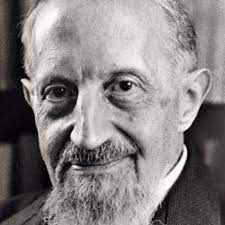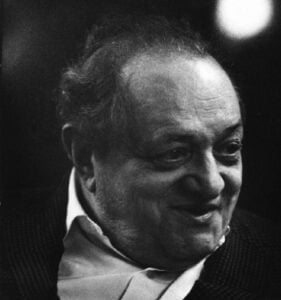Session 8: What is the difference between Assagioli, Gestalt and psychodrama theory and the treatment method based on reference groups [RGFT]
Good day!
Here we will refer to three different types of treatments that have similarities with RGFT and we will examine the differences between them.
The first of these is the theory and method of treatment proposed by Roberto Assagioli.
Roberto Assagioli was an Italian psychoanalyst who was influenced by both Freud and Jung in creating the theory and treatment method that he called "psychosynthesis."

Roberto Assagioli
Assagioli expanded the teaching founded by Freud through the expansion of the unconscious so that it could include the collective unconscious and the archetypes.
As he himself stated: “We pay far more attention to the higher unconscious and to the development of the transpersonal self. In one of his letters Freud said, “I am interested only in the basement of the human being.” Psychosynthesis is interested in the whole building. We try to build an elevator which will allow a person access to every level of his personality. After all, a building with only a basement is very limited. We want to open up the terrace where you can sun-bathe or look at the stars. Our concern is the synthesis of all areas of the personality. That means Psychosynthesis is holistic, global and inclusive”.
The 7 core concepts of psychosynthesis are:
- disidentification
- the personal self
- the will
- the ideal model
- synthesis
- the superconscious
- the transpesonal Self
Beside “disidentification”, all these concepts can be in this or other way derived from the well known Freudian and Jungian postulates.
We cite Assagioli here because some of his theoretical elaborations sound similar to RGFT and therefore demand clarifications. Specifically, he spoke of “sub-personality” (the same term is used in earlier mentioned by us “Voice dialogue”). This concept resembles in some way a concept of the “secondary self” in RGFT. But, as in the “Voice dialogue”, it represents more a partial “feature” of a person (architypal or otherwise originated) and not a personally significant character that could be traced in the person’s history as in RGFT. Still, the concept of disidentification is identical to that in RGFT and serves analogous purpose – it reveals the true nature of our identity with a specific attitude or behavior and allows us to extend our consious choices. Finally, the key concepts of Assagioli root in some part in the spiritual world, whereas RGFT is based mostly on the theoretical constructs of social psychology.
We will now refer to the treatment of the Gestalt approach.
Gestalt therapy is a humanistic, holistic, person-focused approach to psychotherapy that focuses on the person's current life and challenges instead of delving into past experiences.
This approach emphasizes the importance of understanding the context of a person's life and taking responsibility instead of blaming.

Frederick Solomon (Fritz) Perls
Gestalt, by definition, refers to the shape of a thing and suggests that the whole is greater than the sum of its parts. Gestalt treatment focuses on how we give meaning and understand our world and our experiences. Gestalt therapy was developed by Fritz Perls, with the help of Laura Perls, his wife then, and was introduced in the 1940s as an alternative to the more traditional psychoanalysis. Both Fritz and Laura were trained in Gestalt psychoanalysis and psychology. Together with others, they worked together to develop a treatment style that was humanistic in nature. In other words, the approach focused on the person and the uniqueness of his/her experience. There are a number of principal ideas that are expressed in Gestalt therapy, from perception to self-awareness.
First, experience influences perception in this client-centered approach, Gestalt therapist understands that no one can be completely objective and that we are influenced by our environment and our experiences. A therapist trained in Gestalt therapy gives his patients space to share their truth, he will not enforce his own judgment and accept their truth about their experiences as therapists are human as well. Therapists use various techniques to help patients become more aware of their experiences, perceptions, and responses to events in “here and now”. Instead of focusing specifically on the past and asking patients to bring up old experiences, Gestalt therapists operate with the understanding that as clients become more and more aware of the here and now, they will overcome existing obstacles. The main hallmark of Gestalt treatment is therefore the focus on the present. A Gestalt therapist will help bring the patient back to the present if there is a feeling that he is too busy in the past or if his anxiety may accelerate him into the future. An example of maintaining a client's presence in the present may include something like asking the client about his or her facial expressions or body language while processing a particular event or experience.
At the heart of Gestalt therapy is awareness. As Frederick Solomon Perls put it, "Awareness in itself is healing." Instead of sitting quietly and talking, the patient may be asked to actively participate in role-playing, guided imagery or using various props to open up and share, especially when it is difficult to find words. Gestalt therapists understand that these exercises help increase awareness.
Therapeutic approach techniques used in Gestalt include, among others:
1] Emphasis on words and language. Attention to language and tone is important in Gestalt treatment. When patients learn to accept responsibility, they learn to use language that reflects a sense of personal relevance instead of focusing on others.
2] The use of "I" statements is important in the treatment of gestalt.
3] The empty chair, this is a role-playing exercise that allows the patient to imagine and participate in a conversation with another person or with another part of himself. Sitting in front of the empty chair, the patient enters into a dialogue as if he is talking to the same other person or to the same other part of himself. The empty chair exercise can help patients become more aware of their emotional experience and how to procede with healing.
4] Body language. During the session the Gestalt therapist notices the patient's body language and movement. The therapist may mention this and ask what is happening to the patient at the moment. In using language, the Gestalt therapist may even ask the patient to give voice to his or her foot, or facial expression, a voice and speak from that place.
5] Exaggeration. In addition to giving voice to the body language, the Gestalt therapist may ask about the client's interpretation of body language. If it is difficult for the client to find words to confirm what is happening, they may be asked to exaggerate this movement or repeat it several times in a row during the session in order to at least partially elevate their experience at that moment. The patient and therapist are given here an opportunity to process emotions. Talking about emotion is different from experiencing it. When a client talks about emotion, the therapist may ask him where he feels that emotion in his body. The ability to bring the emotional experience to consciousness in the body helps the patient to remain in here and now and process his emotions more effectively.
6] Creative art and other activities such as painting, sculpture and drawing can also be used to help people gain awareness, stay present and learn how to live the moment.
What are the differences between the gestalt therapy and the treatment method based on reference groups [RGFT]?
The significant difference is related to the fact that Gestalt is based on Gestalt's psychological theory which assumes a single existing self though referring to its different parts while the treatment method based on reference groups speaks of multiple selves.
In addition, the reference in Gestalt is mainly to the contemporary experience, while in the treatment method based on reference groups, the reference is to the unconscious influence of internalized figures, using representations of real figures from the person's past.
Although the two approaches use the hot chair method, the use is different in that in Gestalt the reference is broad and includes not only figures but also body parts and broad representations with an emphasis on the here and now experience whereas in the RGFT the emphasis is on exposing internalized figures of the patient.
We will now discuss psychodrama.
The psychodrama approach was developed by Moreno, a Professional theater actor, the theoretical basis is derived from an analytical approach while the therapeutic technique is reminiscent of the theatrical experience with the use of other participants to simulate meaningful figures for the patient.
Psychodrama is a type of experiential, action-based therapy in which people explore issues by presenting (“replaying”) events from their past.
This type of therapy combines aspects of role-playing, dramatic self-presentation and group dynamics to help people gain insights into their lives and experiences. While therapy functions as individual therapy, it uses a group format. The conceptualization behind therapy is rooted in psychology, but it also combines elements of theater and sociology.
Therapeutic sessions are usually performed once a week in a group of eight to a dozen people.
The session usually lasts up to two hours. Each session usually focuses on one person within the group. Other members of the group will adopt supportive roles during the meeting according to what is needed. There are three basic components of a psychodrama encounter:
The Warm-Up Phase,
The Action Phase,
The Sharing Phase.

Jacob Moreno
In the warm-up phase, group members introduce themselves, work on building trust and create a sense of group cohesion.
The action phase includes the creation and play of a scene from the life of the individual. Here the therapist serves as a director to guide the individual, known as the protagonist, and others in the group through the scene using various techniques that include:
1] Double: It involves a team member playing the hero's feelings and behaviors. This player will say what he believes the protagonist thinks or what he appears to be blocking or not sharing. There may be more than one double. This activity creates a connection between the inner reality of the protagonist and the reality of the outer world.
2] Mirroring: The person watches others as they perform scenes, events and conversations related to him, so that the person can reflect on it. This technique can be useful to help people gain perspective or when someone needs some emotional distance to better understand their feelings.
3] Role play: In this technique the person embodies a particular person or object, which is a source of stress or conflict in his life.
4] Role reversal: This technique involves the protagonist playing the role of another person in his life while another actor plays the role of the protagonist. It can help improve the empathy and understanding of another person's point of view.
5] The protagonist's speaking to the group: In this technique, the protagonist describes his inner thoughts and feelings to the audience. The purpose of this is to help a person gain more insight into his inner feelings and thoughts and help promote venting of emotions [catharsis].
The sharing phase includes the participants’ sharing of their experience where the therapist helps to understand the feelings and thoughts that have surfaced. The hope is that this sharing will lead to insight and change.
What are the differences between psychodrama and the treatment method based on reference groups [RGFT]?
First, we note that the use of treatment group participants involves effects that are not directly related to the patient's own significant figures.
Second, in psychodrama the participants play only partially the significant characters and not the integral representation of the internalized figures.
Contrariwise, in the treatment method based on reference groups [RGFT], the person embodies the whole complex of the significant character while the specifically built character’s interview in RGFT is meant to reveal the character in its entirety.
See you in the next session,
Dr. Igor Salganik & Prof. Joseph Levine
 Prof. Joseph Levine, M.D. is an emeritus associate professor in the Division of Psychiatry, Faculty of Health Sciences, Ben Gurion University in Israel. Prof. Levine is a certified psychiatrist with clinical experience in controlled trials of adult psychiatric disorders and in psychotherapy. He was awarded a NRSAD independent investigator grant for the study of Creatine Monohydrate in psychiatric disorders -- mainly Schizophrenia. He resides and treats patients in Tel Aviv and all of central Israel.
Prof. Joseph Levine, M.D. is an emeritus associate professor in the Division of Psychiatry, Faculty of Health Sciences, Ben Gurion University in Israel. Prof. Levine is a certified psychiatrist with clinical experience in controlled trials of adult psychiatric disorders and in psychotherapy. He was awarded a NRSAD independent investigator grant for the study of Creatine Monohydrate in psychiatric disorders -- mainly Schizophrenia. He resides and treats patients in Tel Aviv and all of central Israel.
Leave a comment